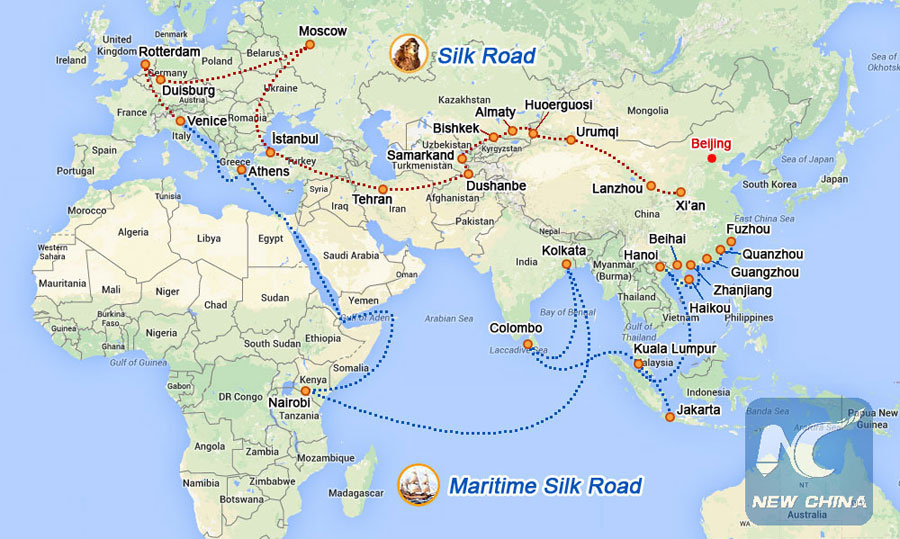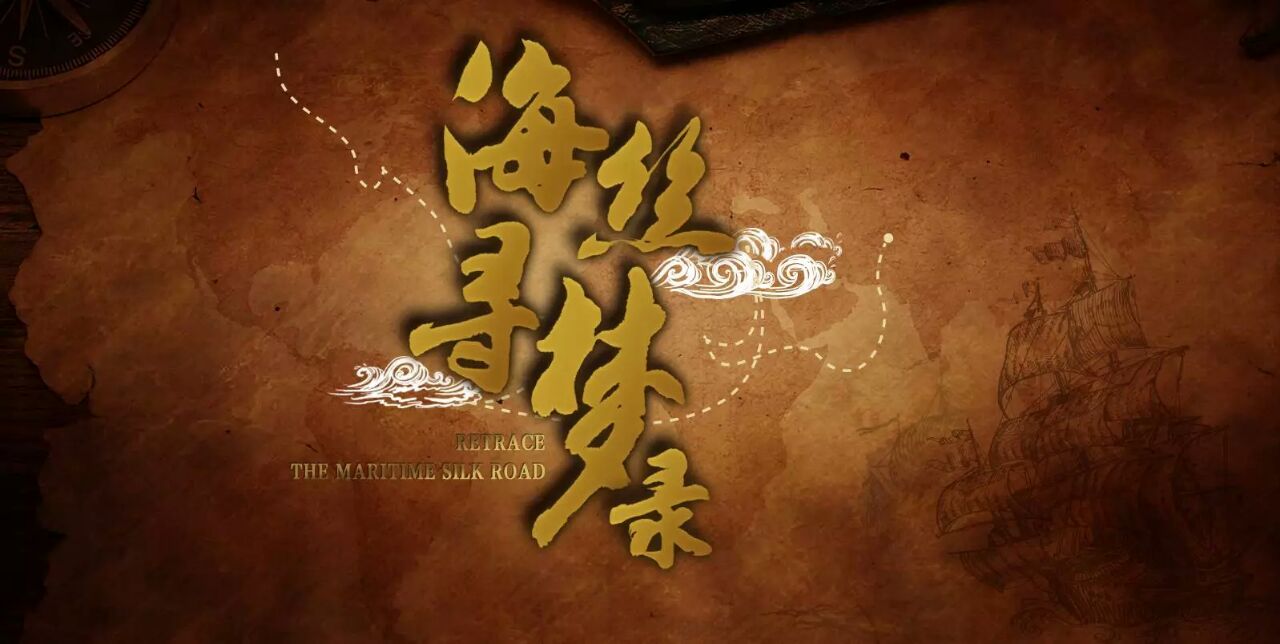Recently a Laotian song featuring the Belt and Road Initiative (the B&R Initiative) went viral online. In the meantime, the Belt and Road Forum for International Cooperation held in Beijing from May 14th to 16th also caught great attention among the public. But even though this topic has been discussed frequently, so many people still don’t fully understand it. Therefore, from now on, a series of reports of the Initiative will be presented on GDUFS official website, and this article is going to kick off from a general perspective.

A total of 29 foreign heads of state and government leaders attended the Forum. Other delegates were representatives from over 130 countries and over 70 international organizations.
What exactly is the B&R Initiative?
The B&R Initiative mainly includes two aspects: one is the Silk Road Economic Belt (the Belt) and the other is the 21st-Century Maritime Silk Road (the Road). Firstly proposed by Chinese President XI Jinping in Kazakhstan and Indonesia in 2013, the initiative aims to enhance economic and cultural development of relative countries via mutual cooperation. Over the past four years, over 100 countries and international organizations have supported and participated in this initiative, which helps the vision gradually become a reality and bear rich fruits.
What are the differences between the Chinese ancient silk routes and the B&R?
China and the countries along the B&R are going to construct six economic corridors: the China-Mongolia-Russia corridor, the China-Central Asia-Western Asia corridor, the China-Indochina Peninsula corridor, the China-Pakistan corridor, the Bangladesh-China-India-Myanmar corridor as well as the New Eurasian Land Bridge. Unlike the ancient silk routes that connected China and the countries in West Asia, Middle Asia and the Mediterranean, the B&R Initiative focuses on Asian, European and African countries, but is also open to all other countries that can be the international partners.

A diagram of the B&R
Through the ancient silk routes, Chinese silk, porcelains and ironware were brought to the West, while peppers, grapes and spices travelled to China. Today, the cooperation along the B&R is stepped up in infrastructure, cultural exchanges, trade and investment, which boosts cooperative diversification. People used to transport goods by camels and ships; today, developed and systematic transportation can help transport goods faster and make people’s lives along the B&R more colorful.
What achievements has the B&R Initiative made?
The fruitful achievements mainly express themselves in five aspects: policy connectivity, infrastructure connectivity, trade connectivity, financial connectivity and people-to-people connectivity.
China has signed memoranda of understanding on B&R cooperation with countries such as Pakistan, Nepal and Singapore, and signed cooperation documents with international organizations including the United Nations Economic Commission for Europe. Supported by the cooperative policies, infrastructure construction can be implemented smoothly. For example, Indonesian Jakarta-Bandung High-Speed Railway is one of the fruitful results. In addition, Chinese government has also signed the economic and trade cooperation agreements with the governments of 30 countries,which aims to promote unimpeded trade. Via the cooperation with organizations such as the Asian Development Bank, the European Investment Bank andthe World Bank Group, financial connectivity can be strengthened. China also improves people’s livelihood with continuous efforts. On the road, it will provide replenishment to support the implementation of projects like the 100 Anti-Poverty Projects and 100 Health Recovery Projects. All these achievements embody the power of the B&R Initiative.
At the Belt and Road Forum for International Cooperation, President XI Jinping pointed out that development holds the master key to solving all problems. With the economic trend nowadays, “we should built the Belt and Road into a road for peace, a road of prosperity, a road of opening up and a road of innovation.”
Guangdong yields fruitful results implementing the Initiative
As China's first province to forward the B&R Initiative's implementation plan, Guangdong has pledged to be the strategic hub, economic cooperation center and essential development engine of the country. Since its promise made on June 3rd 2015, Guangdong has made all-round achievements in this regard.
As of 2016, Guangdong has established friendship worldwide and has 175 sister provinces, states and cities. These friendly relationships help facilitate mutual exchanges in terms of trade, economy and culture and at the same time boost mutual economic growth. For example, the contract value between Guangdong and countries along the B&R totaled over $88 million from 2013 to 2016, with an average annual growth of 6.4%. And another example falls on the 121st Canton Fair in the past two months. According to a report, the fair attracted 196,490 buyers in total, registering a year-on-year growth of 5.9% with a total transaction value of 206.3 billion yuan, up 6.9% from last year. The 21st Century Maritime Silk Road International Expo, held for 3 years in a row in Guangdong since 2014, is also a highlighted practice of this province.
Under the strategy of innovation-driven development, Guangdong is dedicated to economic transformation and upgrading, which influences the way it cooperates with its international partners. For instance, it's reported that in this year's first Canton Fair, buyers were looking for three kinds of products, that is, high-tech products, high value-added products and green products, which can testify to Guangdong's efforts to improve its economic quality.
Cultural exchange is indispensable in the relationships between Guangdong and other countries, and people from different regions play a crucial part in maintaining these relationships. For the time being, many projects are set up to attract more foreign experts to Guangdong and to encourage more local talents to make contributions in the B&R countries. Various examples can be found in the 3-episode documentary co-made by the Promotion Department of CPC Guangdong Committee and Guangdong Radio and Television. The documentary, called Retrace the Maritime Silk Road, was launched in May this year, talks about the history of the ancient Silk Road and covers Guangdong's development in terms of manufacturing, trade, logistics and infrastructure. Besides, many projects, including the volunteer teaching to Madagascar, present the frequent interactions between Guangdong and its international partners.

The documentary – Retrace the Maritime Silk Road
GDUFS takes actions to support the B&R Initiative
Established in 2009,Guangdong Institute for International Strategies (GIIS) isa research consultancy institute with GDUFS as its functional base. Asone of the presidencies of the Belt and Road Think Tank Association, GIIS focuses on issues including the 21st-Century Maritime Silk Road and has made great achievements.
Based on the construction of GIIS, the Collaborative Innovation Center for 21st-Century Maritime Silk Road Studies is also an important institution led by GDUFS. In 2016, cooperating with GIIS, the center held the China (Guangdong) International Think Tank Forum of 21st-Century Maritime Silk Road where experts from different countries had a heated discussion on how to inject new impetus into the development of the B&R. Besides, it also held the China-ASEAN Production Capacity Cooperation Symposium (ASEAN is short for the Association of Southeast Asian Nations) and other cultural events.


GDUFS has held several training courses for students from South Pacific island countries. And leaders of GDUFS also have been to these countries to carry out research studies over the past few years.
In 2015, GDUFS added Bahasa Melayu and Urdu as two new minority languages to support the B&R Initiative. This year, GDUFS will add another five minority languages consisting of Serbian, Farsi, Bengalese, Turkish and Czech, fulling utilizing the comprehensive teaching advantages of GDUFS.
SUI Guangjun, Party Secretary of GDUFS, expressed his expectations of GDUFS students: “Hope you can build up your physical health and enhance your comprehensive abilities.” He also pointed out that, in the future, young adults will be the main force to shoulder the heavy responsibility and make contributions to the B&R.

